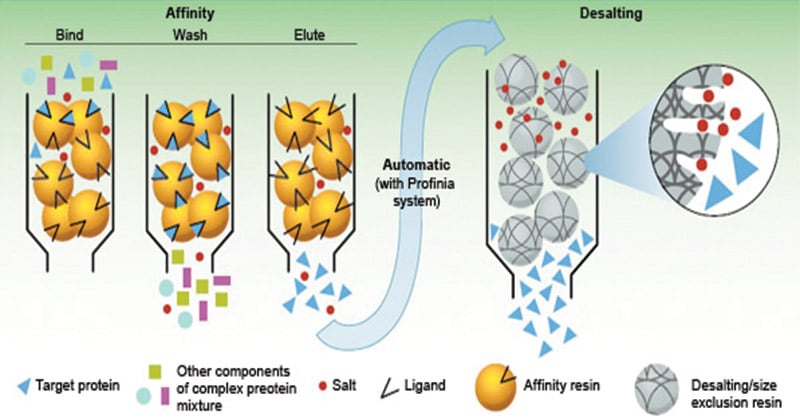Interesting Science Videos
What is Affinity Chromatography?
- Chromatography is an important biophysical technique that enables the separation, identification, and purification of the components of a mixture for qualitative and quantitative analysis.
- It is a separation technique in which a mobile phase carrying a mixture is caused to move in contact with a selectively absorbent stationary phase.
- Affinity chromatography is a type of liquid chromatography for the separation, purification or specific analysis of sample components.
- It utilizes the reversible biological interaction or molecular recognition called affinity which refers to the attracting forced exerted in different degrees between atoms which cause them to remain in combination.
Example: Enzyme with an inhibitor, antigen with an antibody, etc.
- It was discovered by Pedro Cuatrecasas and Meir Wilcheck.

Principle of Affinity Chromatography
- The stationary phase consists of a support medium, on which the substrate (ligand) is bound covalently, in such a way that the reactive groups that are essential for binding of the target molecule are exposed.
- As the crude mixture of the substances is passed through the chromatography column, substances with binding site for the immobilized substrate bind to the stationary phase, while all other substances is eluted in the void volume of the column.
- Once the other substances are eluted, the bound target molecules can be eluted by methods such as including a competing ligand in the mobile phase or changing the pH, ionic strength or polarity conditions.
Components of Affinity Chromatography
1. Matrix
- The matrix is an inert support to which a ligand can be directly or indirectly coupled.
- In order to for the matrix to be effective it must have certain characters:
- Matrix should be chemically and physically inert.
- It must be insoluble in solvents and buffers employed in the process
- It must be chemically and mechanically stable.
- It must be easily coupled to a ligand or spacer arm onto which the ligand can be attached.
- It must exhibit good flow properties and have a relatively large surface area for attachment.
- The most useful matrix materials are agarose and polyacrylamide.
2. Spacer arm
- It is used to improve binding between ligand and target molecule by overcoming any effects of steric hindrance.
3. Ligand
- It refers to the molecule that binds reversibly to a specific target molecule.
- The ligand can be selected only after the nature of the macromolecule to be isolated is known.
- When a hormone receptor protein is to be purified by affinity chromatography, the hormone itself is an ideal candidate for the ligand.
- For antibody isolation, an antigen or hapten may be used as ligand.
- If an enzyme is to be purified,a substrate analog, inhibitor, cofactor, or effector may be used as a the immobilized ligand.
Steps in Affinity Chromatography
- Affinity medium is equilibrated in binding buffer.
- Sample is applied under conditions that favor specific binding of the target molecule(s) to a complementary binding substance (the ligand). Target substances bind specifically, but reversibly, to the ligand and unbound material washes through the column.
- Elution is performed specifically, using a competitive ligand, or non-specifically, by changing the pH, ionic strength or polarity. Target protein is collected in a purified, concentrated form.
- Affinity medium is re-equilibrated with binding buffer.
These events can be summarized into the following three major steps:
1. Preparation of Column
- The column is loaded with solid support such as sepharose, agarose, cellulose etc.
- Ligand is selected according to the desired isolate.
- Spacer arm is attached between the ligand and solid support.
2. Loading of Sample
- Solution containing a mixture of substances is poured into the elution column and allowed to run at a controlled rate.
3. Elution of Ligand-Molecule Complex
- Target substance is recovered by changing conditions to favor elution of the bound molecules.
Applications of Affinity Chromatography
- Affinity chromatography is one of the most useful methods for the separation and purification of specific products.
- It is essentially a sample purification technique, used primarily for biological molecules such as proteins.
Its major application includes:
- Separation of mixture of compounds.
- Removal of impurities or in purification process.
- In enzyme assays
- Detection of substrates
- Investigation of binding sites of enzymes
- In in vitro antigen-antibody reactions
- Detection of Single Nuceotide polymorphisms and mutations in nucleic acids
Advantages of Affinity Chromatography
- High specificity
- Target molecules can be obtained in a highly pure state
- Single step purification
- The matrix can be reused rapidly.
- The matrix is a solid, can be easily washed and dried.
- Give purified product with high yield.
- Affinity chromatography can also be used to remove specific contaminants, such as proteases.
Limitations of Affinity Chromatography
- Time consuming method.
- More amounts of solvents are required which may be expensive.
- Intense labour
- Non-specific adsorption cannot be totally eliminated, it can only be minimized.
- Limited availability and high cost of immobilized ligands.
- Proteins get denatured if required pH is not adjusted.
References
- Wilson, K., Walker, J. (2018). Principles and Techniques of Biochemistry and Molecular Biology (8 eds.). Cambridge University Press: New York.
- https://www.med.unc.edu/pharm/sondeklab/files/resource-files/protein-purification-handbooks/Affinity%20chromatography.pdf
- https://www.slideshare.net/poojakamble1609/affinity-chromatography-ppt
- https://www.sigmaaldrich.com/content/dam/sigmaaldrich/docs/promo_NOT_INDEXED/General_Information/1/ge-affinity-chromatography.pdf
- https://www.slideshare.net/sagarsavale1/affinity-chromatography-56328075
- https://www.shodex.com/en/da1/09/0201.html
- https://www.slideshare.net/asimsami/affinity-chromatography-73800707

Hello, this is very educative and simple enough to understand
very helpful content to clear basic about affinity chromatography